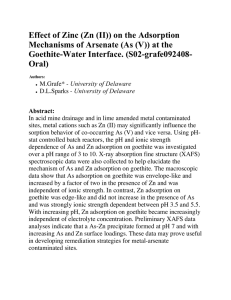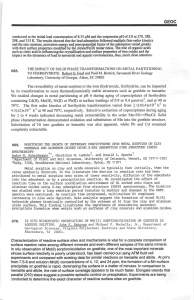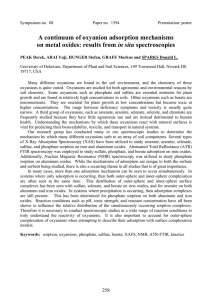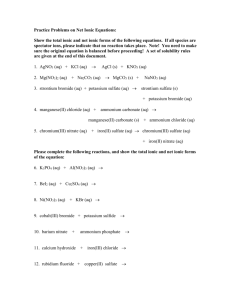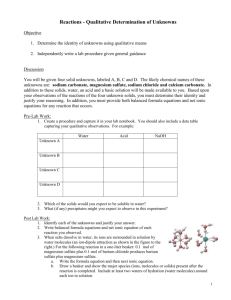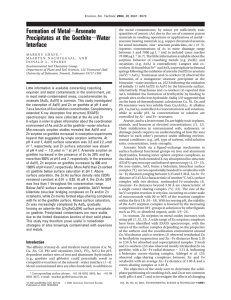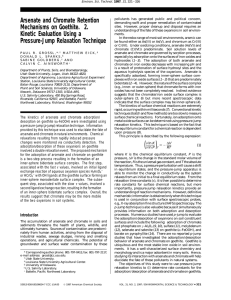KINETICS OF OXYANION SORPTION ON ...
advertisement
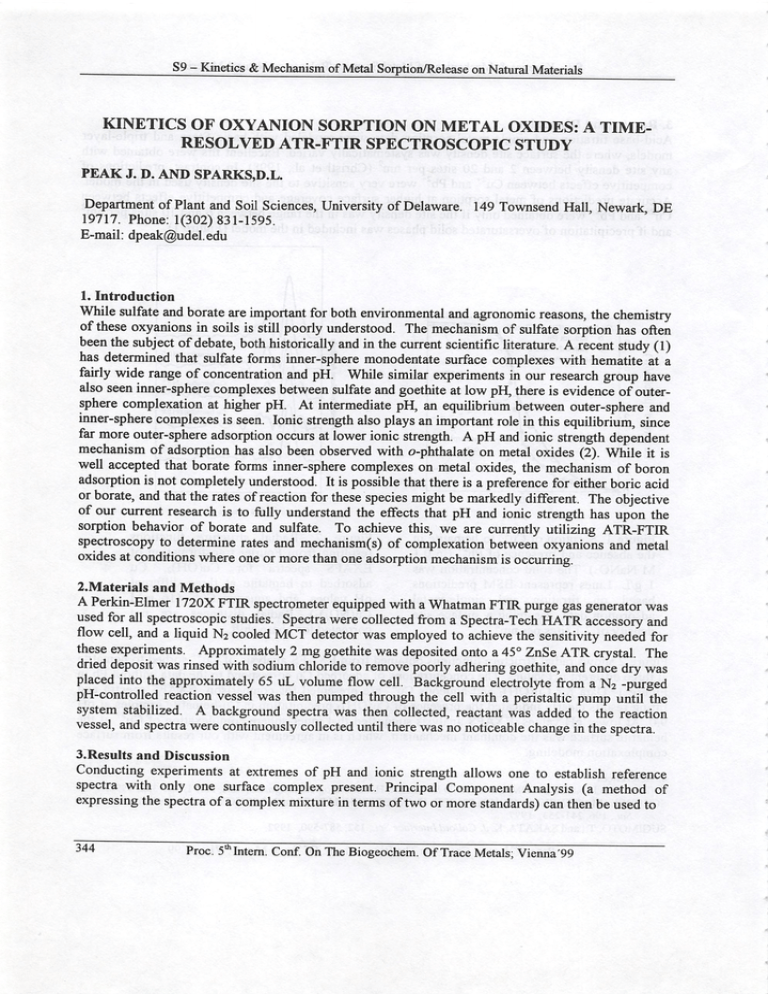
S9 - Kinetics & Mechanism of Metal Sorption/Release on Natural Materials KINETICS OF OXYANION SORPTION ON METAL OXIDES: A TIMERESOLVED ATR-FTIR SPECTROSCOPIC STUDY PEAK J. D. AND SPARKS,D.L. Department of Plant and Soil Sciences, University of Delaware. 149 Townsend Hall, Newark DE 19717. Phone: 1(302) 831-1595. E-mail: dpeak@udel.edu 1. Introduction While sulfate and borate are important for both environmental and agronomic reasons, the chemistry of these oxyanions in soils is still poorly understood. The mechanism of sulfate sorption has often been the subject of debate, both historically and in the current scientific literature. A recent study (1) has determined that sulfate forms inner-sphere monodentate surface complexes with hematite at a fairly wide range of concentration and pH. While similar experiments in our research group have also seen inner-sphere complexes between sulfate and goethite at low pH, there is evidence of outer- sphere complexation at higher pH. At intermediate pH, an equilibrium between outer-sphere and inner-sphere complexes is seen. Ionic strength also plays an important role in this equilibrium, since far more outer-sphere adsorption occurs at lower ionic strength. A pH and ionic strength dependent mechanism of adsorption has also been observed with o-phthalate on metal oxides (2). While it is well accepted that borate forms inner-sphere complexes on metal oxides, the mechanism of boron adsorption is not completely understood. It is possible that there is a preference for either boric acid or borate, and that the rates of reaction for these species might be markedly different. The objective of our current research is to fully understand the effects that pH and ionic strength has upon the sorption behavior of borate and sulfate. To achieve this, we are currently utilizing ATR-FTIR spectroscopy to determine rates and mechanism(s) of complexation between oxyanions and metal oxides at conditions where one or more than one adsorption mechanism is occurring. 2.Materials and Methods A Perkin-Elmer 1720X FTIR spectrometer equipped with a Whatman FTIR purge gas generator was used for all spectroscopic studies. Spectra were collected from a Spectra-Tech HATR accessory and flow cell, and a liquid N2 cooled MCT detector was employed to achieve the sensitivity needed for these experiments. Approximately 2 mg goethite was deposited onto a 45° ZnSe ATR crystal. The dried deposit was rinsed with sodium chloride to remove poorly adhering goethite, and once dry was placed into the approximately 65 uL volume flow cell. Background electrolyte from a N2 -purged pH-controlled reaction vessel was then pumped through the cell with a peristaltic pump until the system stabilized. A background spectra was then collected, reactant was added to the reaction vessel, and spectra were continuously collected until there was no noticeable change in the spectra, 3.Results and Discussion Conducting experiments at extremes of pH and ionic strength allows one to establish reference spectra with only one surface complex present. Principal Component Analysis (a method of expressing the spectra of a complex mixture in terms of two or more standards) can then be used to 344 Proc. S"" Intern. Conf. On The Biogeochem. Of Trace Metals; Vieina'99 S9 - Kinetics & Mechanism of Metal Sorption/Release on Natural Materials estimate the relative amount of each complex in samples of more intermediate pH and ionic strength where more than one complex is present. We have learned via ATR-FTIR spectroscopy that the adsorption behavior of sulfate on goethite is unchanged over a wide range of initial concentrations for any given pH. This is in good agreement with the findings of Hug (1), and makes it possible to evaluate the time-dependence of sulfate reactions with goethite. By optimizing experimental parameters such as the number of co-added scans, resolution, mirror speed, and rate of flow through the flow cell, it is possible to follow the reaction of sulfate in real time (See Figure I). This allows one to simultaneously determine both the rate parameters (by normalizing the integrated absorbance and fitting the data as a function of chamber volume) and the mechanism(s) of adsorption. Figure 1 (a) Spectra of adsorbed sulfate as a function of chamber volumes through the flow cell. Reaction conditions were 0.01 N NaCl, pH 4.00, 25 |iM 804^" and 1.28 mL min' flow rate, (b) A plot of the integrated absorbance from 950-1250 cm"' for the same experiment. a) 400 1 2 0 0 11 5 0 11 0 0 1 0 6 0 1 0 0 0 600 800 1200 C h a m b e r Vo l u m e s Wavelength (cm*') 4. References HUG, S. 1997. In Situ Fourier Transform Infrared Measurements of Sulfate Adsorption on Hematite in Aqueous Solutions. J Colloid and Interface Science. 188:415-422 „ „ PERRSON, P., NORDIN, J., ROSENQVIST, J., LOVGREN, L., OHMAN, L., AND SJOBERG, S. 1998. Comparison of the Adsorption of o-Phthalate on Boehmite, aged Y-AI2O3, and Goethite. J Colloid and Interface Science. 206; 252-266 Proc. 5*^ Intern. Conf. On The Biogeochem. Of Trace Metals; Vienna'99 345

